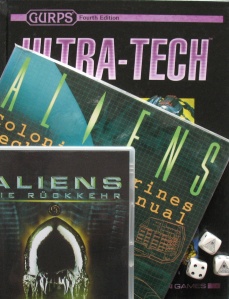OK, I wanna introduce you to a personal friend of mine: This is an M41A pulse rifle, 10mm, with an over-and-under 30mm pump-action grenade launcher.
‒ CPL Dwayne Hicks, 1st Platoon, A Company, 2/9 USCM, in Aliens (1986)
The Armat M41A is the famous weapon arming the US Colonial Marines in Aliens (1986) and the Weyland-Yutani Corporation security forces in Alien 3 (1992) ‒ also, for some obscure reasons, the bank robbers in The Simpsons #13.12 (2002) … It accounts for a lot of the pseudo-realistic setting of Aliens, giving the main characters a mean-looking yet functional weapon to combat the dangerous Xenomorph XX121. Ultimately, the powerful, effective carbine ‒ and all the other ultra-tech gear of the year 2179, from nukes to sharp sticks ‒ does not mean much against the swarm intelligence, evolutionary perfection, and insidious breeding habits of Internecivus raptus, giving the Alien saga a distinct, rather desperate Lovecraft-esque vibe.
The very cool prop was based on an Auto-Ordnance M1A1 Thompson submachine gun with a shortened Remington Model 870 pump-action shotgun mounted under the barrel. The whole package was dressed up to conceal the original weapons and to make it look more futuristic.
Somewhat surprising in view of the film’s heavy reliance on realistic-looking gadgets and realistic-sounding military jargon, Aliens is better suited to be represented with GURPS Gun Fu rather than GURPS Tactical Shooting, like virtually any action flick of the 1980s (Gun Fu, p. 6). Nobody is using cover. Nobody watches their spacing ‒ despite them specifically being reminded to by Lieutenant Scott Gorman. Nobody is using a proper shooting stance, mostly they are using good old hip-shooting. Nobody is using sighted shooting ‒ even the machine gunners prefer to fire their Armat M56 smart guns without their fancy HUD monocles. Nobody is using “short, controlled bursts” ‒ despite Corporal Dwayne Hicks specifically telling them to. Nobody carries ammunition reloads ‒ and we will see why further below. Nobody follows the commands of their superiors. On first contact with the enemy, everybody panics (pp. B360-361). And so on.
Like many of the assumptions of the setting, the M41A pulse rifle looks awesome on screen but does not make quite as much sense if examined more closely (Gun Fu, pp. 38, 39). Below, I provide stats for the M41A in GURPS terms. Some of the information given was adapted from the brilliant Colonial Marines Technical Manual (1995) written by Lee Brimmicombe-Wood. Note that I am taking most of his (made-up) data at face value, including such things as the magazine capacity, muzzle velocity, maximum range, empty weapon weight, etc. I have kept those details that make at least sense in the setting, such as the magazine capacity, but I have ignored others. For example, there is no way a full 99-round magazine weighs only 1.5 kg when each projectile weighs 13.6 g. The complete cartridge weight must lie well over 15 g, which means the 99 rounds alone weigh at least 1.5 kg, plus the empty magazine.
My first attempt at a write-up has been published in my fanzine The Armourer A1 (1998). This latest version is especially suited for use with my article “Tactical Shooting: Tomorrow” in Pyramid #3/55.
Fellow Hellion Douglas Cole has also recently written about the M41A and its ammunition on his blog Gaming Ballistic, using a slightly different approach than I do. Check his site for a comparison.
Armat M41A, 10×24mmCL (USA, 2171-)
The M41A pulse-activated assault carbine with integral grenade launcher was adopted in 2171 as the standard weapon of the US Army and Colonial Marines, as well as several other Terran UN forces and private sector security outfits. It is of conventional layout and features a 26.7-cm carbine barrel, an adjustable retractable stock (GURPS High-Tech, p. 160, and Pyramid 3/55, p. 7), a carrying handle with integral iron sights, and sling swivels (High-Tech, p. 154). It is made from light metal alloys and high-impact plastics. The construction is waterproof and fully certified for vacuum operations (High-Tech, p. 85, and Pyramid 3/55, p. 7), but not suited to zero-G environments (Pyramid 3/55, p. 7). Empty weight is 3.18 kg (7.5 lbs) plus 0.22 kg (0.5 lb) for the sling.
The M41A is chambered for the 10×24mm non-telescoped caseless cartridge (High-Tech, pp. 164-165, GURPS Ultra-Tech, pp. 135, 139, and Pyramid 3/55, p. 4). The standard round is the M309 High Explosive Armour-Piercing (HEAP), firing a pyrotechnically-fused hardcore projectile with secondary explosive effect; GURPS calls this APHEX (High-Tech, p. 170). Such rounds need a certain resistance to set off the pyrotechnical chain of detonation; they will usually not explode upon hitting unprotected humans (3 on a 3d roll). Hard body armour or the protective exoskeleton of the Xenomorph XX121 species is enough (minimum DR 2). APHEX projectiles have the same overall weight as FMJ projectiles, which means that a 10-mm projectile with a length-to-diameter ratio of about 3, the most that can be conviniently fitted into the magazine, would weigh between 13.6 g and 16.7 g. The figure given matches perfectly. To achieve the stated muzzle energy, the propellant would then need to weigh about 4.5 g. Let’s call it 4.4 g, to get an even cartridge weight of 18 g. The cartridge is ignited through an electric pulse controlled from the trigger (Ultra-Tech, p. 135, and Pyramid 3/55, p. 4), hence its name. Using a 10-mm projectile with a weight of 13.6 g and a muzzle velocity of V0 = 840 m/s, the M41A’s muzzle energy would be 4.8 kJ. The muzzle energy would ordinarily generate substantial felt recoil. Due to its advanced recoil compensation, which judging from the massive muzzle blast probably includes a muzzle compensator (Tactical Shooting, p. 76), recoil of the M41A is very manageable.
The ammunition comes in high-density synthetic magazines (High-Tech, p. 155, and Pyramid 3/55, p. 4) holding 99 rounds. This does not work; the prop shown in the film is simply an ordinary Auto-Ordnance Type XX 20-round magazine, 15.6 cm long and 2.4 cm wide, with a larger base. Assuming that the voluminous magazine well actually takes an equally large magazine, then it should have interior dimensions about twice as wide. However, even a quad-stack magazine of the same height would only room 60 rounds, and that is assuming a very advanced spring or elevator. A sextuple-stack magazine would perhaps take 90, but would be much wider and would still be nine rounds short. In other words, this is really a magic pouch with a Hideaway enchantment (GURPS Magic, p. 61), or perhaps more suitably, a prop required by the setting for the Infinite Ammunition (Quasi-Realistic Ammo) perk (Gun Fu, pp. 19-20). The realistic solution to the over-large magazine is of course to reduce the magazine capacity. Shots 50+1 would be appropriate, and indeed this was the solution that fellow Hellion David Pulver chose for his 10-mm Storm Carbine (Ultra-Tech, p. 136). In the setting, the magazines are commonly downloaded to take only 95 rounds, supposedly to improve reliability. This suggests that magazine technology has not improved substantially over current TL8 designs (Tactical Shooting, p. 20, and Pyramid 3/55, p. 4). A magazine holding 99 rounds weighing 18 g each must weigh at least 2 kg. I have assumed 2.04 kg here, to get an even 4.5 lbs.
A display located in front of the trigger on either side of the weapon always shows the number of rounds left as well as status of the powercell (Ultra-Tech, p. 149, and Pyramid 3/55, p. 7). The shot counter, instead of increasing the realism by specifying exactly how many shots remain (Gun Fu, p. 19, and Tactical Shooting, p. 20), actually does not help here, since in the film the shooters are still firing way more shots than even their 99-round magazines hold. Instead, the counter is a plot device to increase the sense of desperation.
Single shots, 4-round limited bursts (High-Tech, p. 83), or full-automatic fire at 900 shots per minute are possible. The action and barrel are mounted on free-floating rails within the high-impact casing of the gun, reducing recoil to a minimum. Electrical power is provided by a rechargeable B powercell in the carrying handle (Ultra-Tech, p. 149, and Pyramid 3/55, p. 8). It will last for 10,000 shots.
Under the rifle barrel is an integral 30×23mmR pump-action grenade launcher designed by PN. It has an underbarrel tube magazine holding up to three grenades, and an additional one can be directly loaded into the breech. The launcher has a separate trigger just in front of the magazine housing, which is used as a handgrip when firing grenades. The standard grenade is the red-capped M40 HE. This can also be used as a hand grenade with a 5-second delay.
Note that the M41A lacks any sophisticated targeting equipment (Ultra-Tech, p. 149, and Pyramid 3/55, pp. 8-10). No targeting laser, no collimating sight, no HUD. Is this a nod to the US Marine Corps, which historically was often underfunded compared to the other US military branches and therefore had to do with less modern weaponry? Not really. On the grand scale of things, a few doodads on rifles cost nothing, especially compared to a dropship carrier like the USS Sulaco. Can this be explained by the close assault-type warfare expected from a spaceborne landing unit like the US Colonial Marines? Again, not really. Something as simple as a red dot sight provides such a distinct advantage in combat, any combat, its absence really cannot explained by tactical considerations. The real reason is probably simply that nobody could foresee in 1986 that the various electronic targeting aids would be so widespread and successful even 30 years later, and even if someone did, the filmmakers would not have been able to represent them accurately. By 2179, shooters really must be expected to be much better equipped.
Note that the US Colonial Marines already possess TL9 flip-down infrared imaging monocles (Ultra-Tech, pp. 60-61). It would be absolutely no stretch at all to make these HUD-compatible (Pyramid 3/55, pp. 8-9).
Rifles Table
See pp. B268-271 for an explanation of the statistics.
GUNS (RIFLE) (DX-4 or most other Guns at ‑2)
| TL | Weapon | Damage | Acc | Range | Weight | RoF | Shots | ST | Bulk | Rcl | Cost | LC | Notes |
| 9 | Armat M41A, 10×24mmCL | 9d-1(2) pi with 1d-2 cr ex [1d-2] cut follow-up | 4 | 550/2,300 | 11.5/4.5 | 12/15 | 99+1(3) | 9† | -5* | 2 | $2,000 | 2 | [1] |
Grenade Launchers Table
See pp. B268-271 for an explanation of the statistics.
GUNS (GRENADE LAUNCHER) (DX-4 or most other Guns at ‑2)
| TL | Weapon | Damage | Acc | Range | Weight | RoF | Shots | ST | Bulk | Rcl | Cost | LC | Notes |
| 9 | Armat M41A, 30×23mmR | 1d(0.5) cr dkb with 6d cr ex [1d+2] cut follow-up | 3 | 17/450 | +0.25 per grenade | 2 | 3+1(3i) | 9† | -5* | 3 | N/A | 2 | [2] |
Notes:
[1] Very Reliable. Won’t malfunction unless lack of maintenance lowers Malf. (p. B407).
[2] First Range figure is minimum range, not 1/2D.

